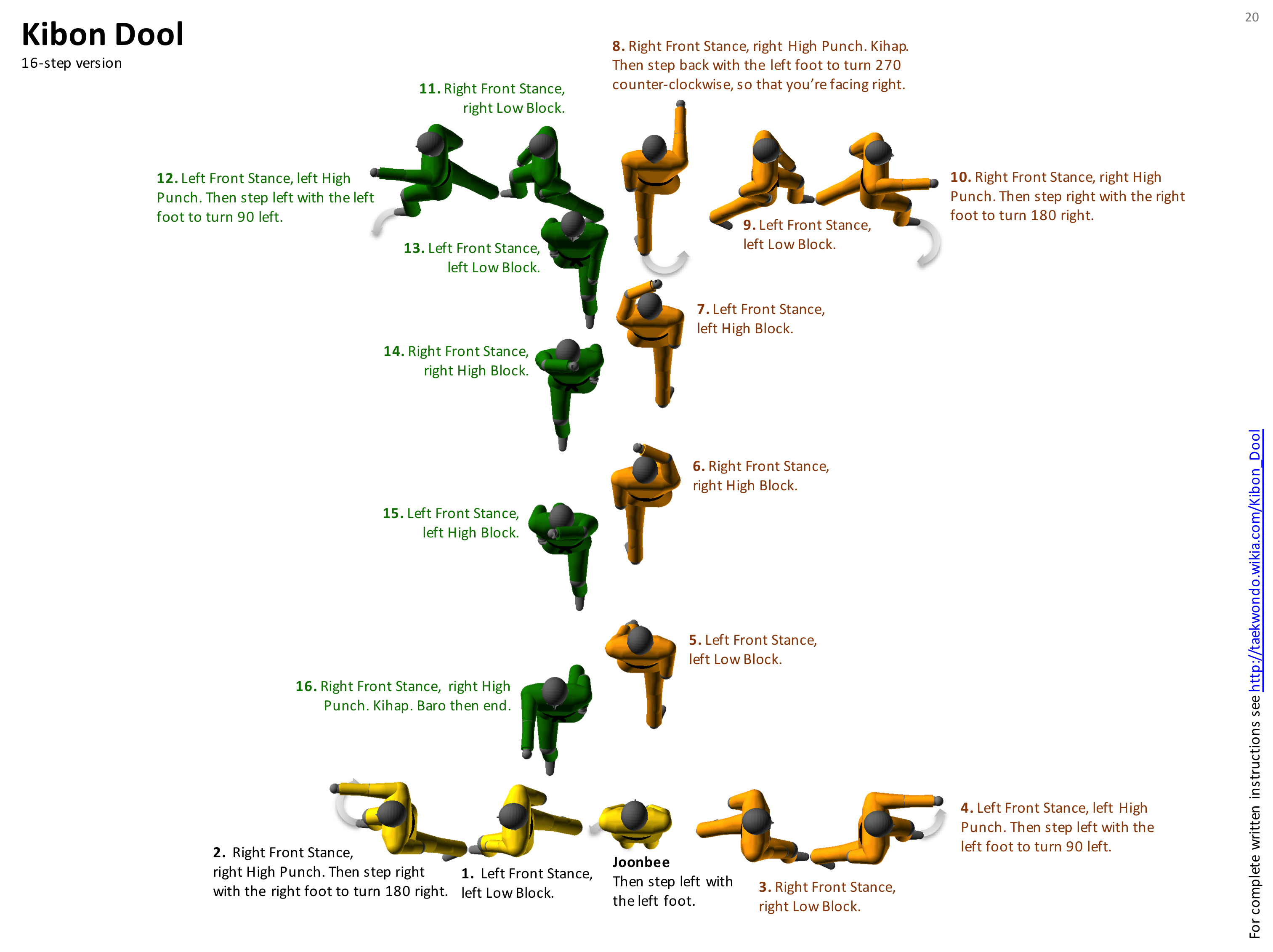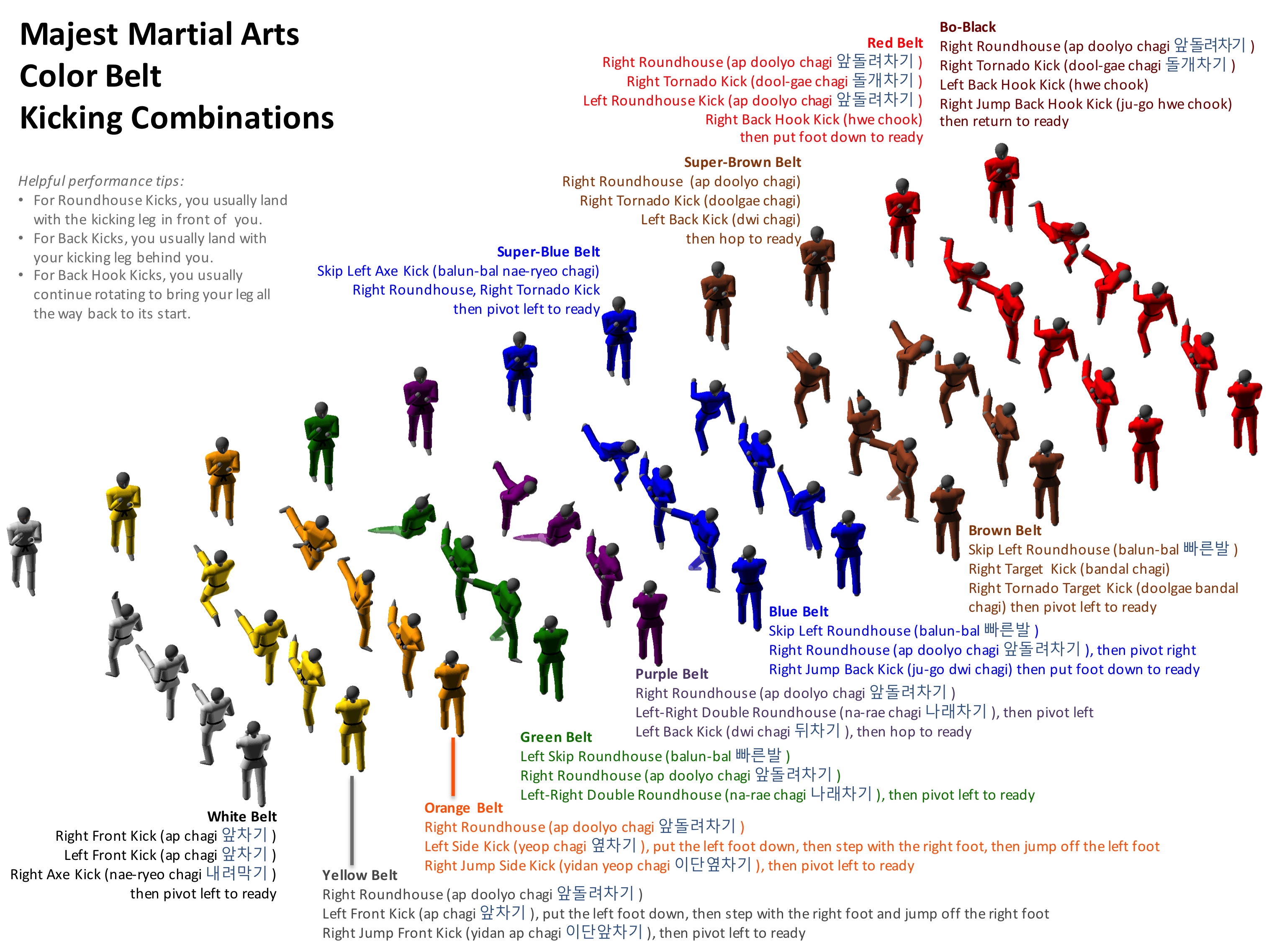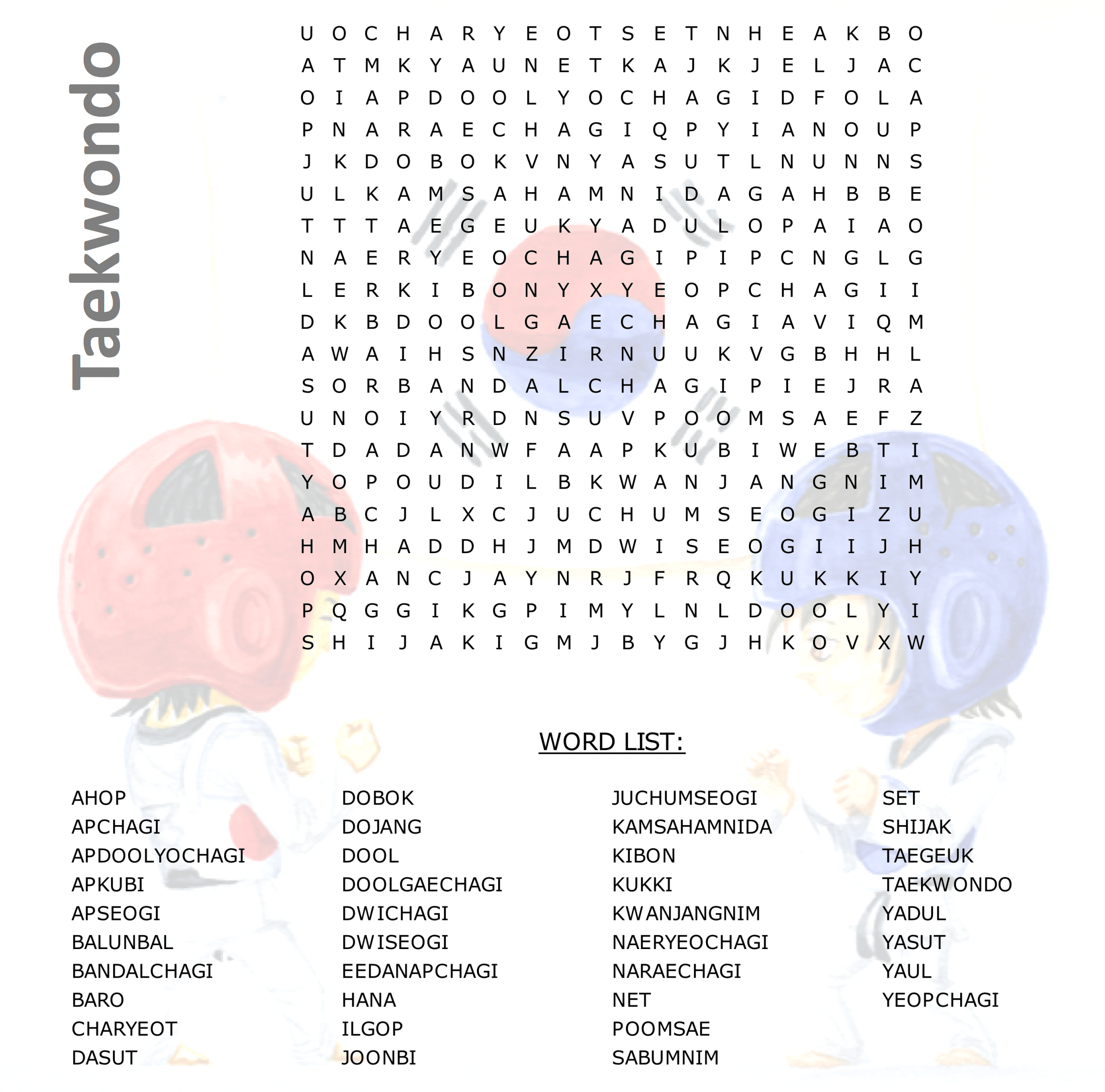Yellow Belt Curriculum
Majest Martial ArtsThe poomsae practiced at Yellow Belt is called Kibon Dool (“Basic #2”). As with the White Belt form, the diagram for this form is an I-shape. You first turn left and perform movements 1 and 2, then turn 180 right to retrace your steps for movements 3 and 4…and so-on throughout the diagram. Whereas the White Belt form incorporated only a few techniques (Low Block, Punch, and Long Stance), Kibon Dool introduces two additional techniques: the High Punch and the High Block. As with the previous poomsae, the key to performing a good High Block is to start with a correct chamber.
Note that for clarity, this diagram shows only the first 16 steps of Kibon Dool. The final four steps are simply a repeat of the starting line.
When students are Color Belt, their ranks are called gup in Korean. The White Belt was the first rank: 10th gup. Now the Yellow Belt is one rank higher: 9th gup. Students proceed through these ranks — 8th gup, then 7th gup, and so on — until they reach 1st gup (Red Belt). After 1st gup, students began their Black Belt training. You can read more about Kibon Dool — Majest’s 9th gup form — including step-by-step instructions, here: Kibon Dool. In addition, the videos below demonstrate how to perform the Kibon Dool, the Majest Yellow Belt kicking combination, and the Majest Yellow Belt breaking technique (an axe kick).
Special Note: At Yellow Belt, students at Majest begin to spar. Remember to swing by the front-desk and and purchase sparring gear, and attend some of the sparring classes on the weekly class schedule.
9th gup - Yellow Belt, Kibon Dool (step by step)
This video shows the Kibon Dool poomsae, step-by-step.
9th gup - Yellow Belt, Kibon Dool (with written instructions)
This video shows the Kibon Dool poomsae, step-by-step, with written instructions.
9th gup - Yellow Belt, Kibon Dool
This video shows Kibon Dool performed at normal speed.
9th gup - Yellow Belt breaking
This video shows the Yellow Belt breaking technique, an axe kick (naeryo chagi). All breaking demonstrations have three kihaps (yells): one yell at the outset of the demonstration, a second as you make impact with the board, and a third yell to finish the demonstration.
Learning to break a board with an axe kick teaches three very important things: flexibility, power, and accuracy. Flexibility is key to success in TaeKwonDo, which is why we begin each class with thorough stretching. The practice of an axe kick also improves a student’s flexibility. On the downward stroke, students must not simply let gravity drop their leg onto the board — the student must use their muscles to pull their leg down onto the board, to give the kick more power. And finally, the most important point of all: accuracy. Boards break easily only when they are struck directly in the center of the board — a few inches off-center, and even a thin board is difficult to break. By practicing the axe kick, students learn the fine motor control necessary to target a large muscle group (the leg muscles) with precision.
9th gup - Yellow Belt kicking combination
This video shows the Yellow Belt kicking combination: a roundhouse kick (ap-dool-yo chagi), a front kick (ap chagi), and a jump front kick (ee-dan ap chagi). The practice of kicking combinations teaches students how to rapidly transition from one kick to the next. When testing, the key is to demonstrate speed, power, and correct technique.
9th gup - How Parents Can Help
Here are things you as a parent can do to help your child with White Belt (10th gup) homework:
- Have your child perform the poomsae for you at home. Some things to look for:
- At White Belt, your child should have learned how to make a correct fist and punch. Make sure your child is still making a good fist and a good punch. Review the parents’ notes in on the White Belt page of this website for additional tips about fists and punching.
- In this form, the punches are high punches — aimed at the opponent’s upper lip. Help your child learn to punch at that height. (Some children exaggerate the high punch, as if punching over their heads!)
- This form introduces the high block, so make sure your child is chambering for the high block correctly. The blocking fist should start at the opposite waist, palm up — then rotate the blocking arm upward to cover the head about one fist-width away from the forehead, angled so that the forearm is like an umbrella keeping rain off your child’s eyes. Meanwhile, the opposite fist starts chambered with the thumb on the collar-bone, then comes down to the waist palm-up.
 Work on ankle-control drills at home: from a seated position, have the child extend both legs forward. First, take turns straightening the ankle on each foot so that the foot and leg form a single line, with the toes curled downward. When finished, let the ankle return upward into a more natural position. Second, straighten the ankles again, but this time bend the toes backward rather than curling them down. When finished, again let the ankle return upward into a more natural position. Keep practicing until the child can control the ankles independently from the toes. Why is this drill useful? When breaking boards with the foot, being able to control where your toes are makes it easier to delivery a forceful kick (without hurting your toes!).
Work on ankle-control drills at home: from a seated position, have the child extend both legs forward. First, take turns straightening the ankle on each foot so that the foot and leg form a single line, with the toes curled downward. When finished, let the ankle return upward into a more natural position. Second, straighten the ankles again, but this time bend the toes backward rather than curling them down. When finished, again let the ankle return upward into a more natural position. Keep practicing until the child can control the ankles independently from the toes. Why is this drill useful? When breaking boards with the foot, being able to control where your toes are makes it easier to delivery a forceful kick (without hurting your toes!).- Sparring: At Yellow Belt, students at Majest begin to spar. Sparring is a lot of fun, and it’s a terrific workout! Don’t forget to swing by the front desk and purchase sparring gear as soon as your child has received his or her Yellow Belt, and attend some of the sparring classes on the weekly schedule.
- Obtain a copy of the Majest Yellow Belt test questions well before the test, and practice the test questions (including Korean vocabulary) with your child. Below is a “word search” to help with vocabulary training.











